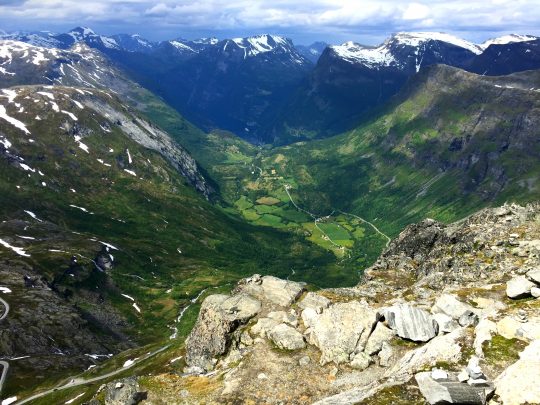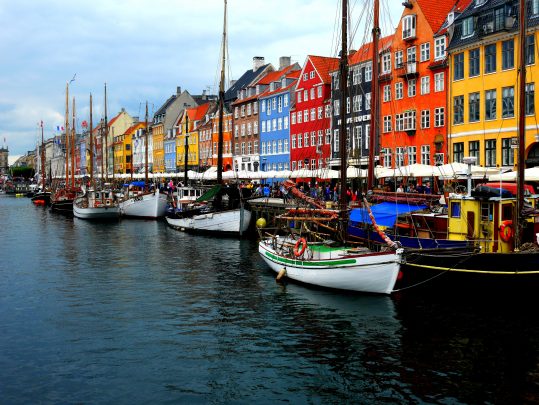Scandinavian cool

Beware the hotel corridor in Stockholm or Oslo. The doors to the rooms open outwards so you might get a shirt-front Scandinavian-style.
I’m not sure what this is all about, but my best guess is that they are saving internal space in the rooms. Then again, I’m not sure they really need to as one thing that seems to characterise Scandinavia, at least in the countryside, is wide-open space with nary a human or animal in view.
It’s tempting to generalise and to lump Scandinavia into an all-encompassing description, but that would be as unfair and inaccurate as describing Australia, with all its diversity and contrasts, in one glib phrase.
Sure, there are things in common between the Norwegians, Swedes and Danes and some of the stereotypes ring true, such as the oodles of fair-skinned, cool blondes, most of them not the bottled variety I would guess. They are generally a happy lot, prepared to smile generously and to take their duty of hospitality with seriousness and professionalism, a bit like the Japanese but without the bowing. Sophisticated, blessed with easy elegance, and deeply concerned to preserve their precious natural environment are other descriptions that might be applied to Scandinavians one and all.
Here are some more specific impressions of our recent expedition in May, when the daylight is just about endless and the climate kind to us warm-blooded Aussies:
Stockholm
With its gracious old town, cute canals and stately public buildings, Stockholm is grandly impressive without trying too hard and without resorting to ostentation. There is something self-effacing, something understated about it and its human scale invites you to tackle it on foot or even better by ferry-boat.
There are some excellent museums, not least of which is that devoted to the Swedish King Gustavus Adolphus’ warship the Vasa. On August 1628, the then state-of-the-art Vasa set sail on her maiden voyage and, after cruising for no more than 1,300m, sank like a stone. The wreck, miraculously intact under the fine silt of Stockholm harbour, was salvaged over 300 years later in 1961. Its beautifully ornate remains, meticulously and faithfully restored, are housed in the museum which is without doubt one of the great museums of the western world.
Oslo
More boats in Oslo. Not surprising given the nautical heritage of the Norwegians. Fascinating boats too: Thor Heyerdahl’s Ra and Kon-Tiki, the record-breaking polar ship the Fram, and possibly the best example, and surely the most handsome, of an original Viking ship anywhere in the world.
A vessel of a different kind is ‘moored’ on the edge of Oslo’s main harbour. This is Oslo’s new Opera House, clad in white marble and sloped towards the bay in a way that suggests a boat emerging from the sea. Or could it be an iceberg?
Let’s not compare it to Sydney’s white sails because comparison risks diminishing the individual distinction of each structure. Let’s just say that it is a modernist classic which, like Sydney’s, will stand the test of time.
Norway
We debated whether the best way to see the Norwegian landscape was to drive from Oslo to the west coast, or whether to board a boat in Bergen and skirt the western fjords on the way to the Arctic Circle. I still don’t know the answer to that debate because we only chose the driving option and therefore have no basis for comparison with the boat.
Let me say, however, that we were not disappointed. If there is a country with more majestic beauty than Norway then I would like to see it.
The benefit of road travel is that we were able to witness such a variety of landscape that we were rarely less than mesmerised by the unspoiled beauty of the lakes, rivers, fjords and mountains all around us. Distances were manageable, the roads good, traffic light, and stopovers in engaging villages and towns offered warm hospitality.



Copenhagen
There is one major problem with Copenhagen. It’s called the Tivoli Gardens. How could that be, you cry. After all isn’t that what everyone puts on top of their visit-list? Ironically enough, we never passed through its ornate gates but what we saw through the fence and other vantage points convinced us that it’s a blight on an otherwise classically elegant European capital.
Right in the heart of Copenhagen, the Tivoli takes the fake into an art form. It’s faux-everything… and even fails as a fun park by modern standards. Demolish it I say, though maybe you could retain the gates which do have a character of sorts.
Thankfully there are many other fine things to do in and around Copenhagen, which has more than its reasonable share of palaces, pedestrian streets, canal-boats, museums and monuments. Not far out from the centre, for example, is the splendid Louisiana museum of contemporary art. Best not compare again, but if one must, then MONA in Hobart is pretty close in terms of the quality of the art and the individuality of its setting.

All things lead to Paris, eventually, so in Copenhagen’s Glyptotek museum we happened upon a special exhibition of the surviving bronze sculptures of Edgar Degas. In addition to the expected ballet dancers were some extraordinary studies of horses in playful carriage and on the gallop, rendered by the artist with a masterly naturalism and fluency.
A splendid end to our Scandinavian (and French, by accident) tour.








 Proudly Australian owned and operated
Proudly Australian owned and operated